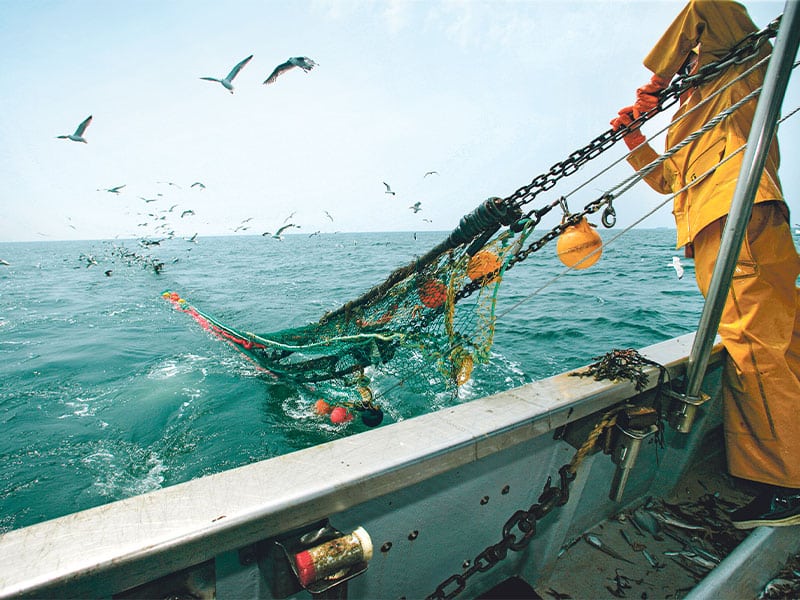Cameras on boats reveal surge in bycatch by commercial fishers
4 min read
On-board cameras have been deployed on more than 100 vessels. Photo: Adobe Stock
Recent data released by the Ministry of Primary Industries (MPI) showed an increase in dolphin, fish, and seabirds captured by the commercial fishing industry following the introduction of on-board cameras.
The figures dated 1 April (compared with the period from 2018 until cameras were operating) showed dolphin captures had increased almost seven-fold while fish discards had spiked by 46 per cent. Additionally, albatross interactions have seen a 3.5 times increase.
On-board cameras were introduced on set net vessels greater than or equal to eight metres in overall length and trawl vessels less than or equal to 32 metres in overall length fishing off the north, east, and south coasts of the South Island on 31 October 2023.
As of 1 April 2024, Spark cameras have been deployed on 123 vessels: 101 inshore trawl and set net vessels and 22 surface longline vessels. A further four vessels are operating the proof-of-concept camera system, taking the total to 127 vessels.
Prior to on-board cameras, Fisheries New Zealand relied on data collected by observers to estimate total captures and risk to protected species from commercial fishing.
“The increased reporting after the rollout of cameras remains in line with these estimates and will continue to be monitored as more data becomes available,” MPI said.
“Future research will use data from cameras to update risk and capture estimates to ensure that these are based on the best available information.”
More vigilance
Seafood New Zealand CEO, Dr Jeremy Helson, said fishers may be more vigilant with reporting bycatch species due to cameras.
“There will be a number of things contributing to the change in reported bycatch since the introduction of cameras. We expect there to be year-on-year fluctuations to consider and therefore wouldn’t draw any conclusions on this limited data. But what we think cameras are doing is causing all fishers to be more vigilant about reporting their catch. This is a good thing.”
Helson added that they support and welcome the transparency that measures such as electronic monitoring and cameras can bring.
“Having this data gives us a fresh baseline with everyone on the same page. It’s a good thing to have increased transparency.
“Our regulator, Fisheries NZ, MPI, manages New Zealand’s fisheries using mathematical models built by scientists, which produce estimated interaction numbers for protected species. These models allow for inconsistencies in reporting – they allow for human fallibility. These models scale up data from MPI observers, so they are representative of the full fishing fleet.
“What we’re seeing so far is within what current models estimate. In other words, the existing models are still accurate, even with the new information from cameras. That means the public can know fisheries were already being conservatively managed to ensure sustainability. Going forward, these new numbers will further strengthen the modelling and subsequent management of our fisheries.”
Mass underreporting
Ocean conservationists say the new data shows that commercial fishing companies have been “massively underreporting” their catches of dolphins, albatross, and fish prior to the cameras on boats programmes.
“It shows us that for decades, the unmonitored commercial fishing fleet has not been accurately reporting their interactions with protected species of dolphin and seabirds, nor the amount of fish they catch and discard,” said Ellie Hooper, Greenpeace oceans campaigner.
“Quite simply, the fishing industry hasn’t been telling the truth. This is exactly why cameras on boats are needed, for all of us to get accurate information about the actual impact fishing has on the ocean, not just numbers that have been dreamt up by industry.”
WWF-NZ echoed the same sentiment, with WWF-NZ CEO Dr Kayla Kingdon-Bebb saying that the increase shows that we have “not had a clear picture to date.”
“The fact we have not had an accurate picture of the threats commercial fishing poses to our threatened species is deeply concerning when you consider that many of these species are on the brink of extinction.
“Electronic monitoring helps us understand the full impact of commercial fishing on New Zealand’s marine environment – and it helps us identify what steps we need to take to ensure improved transparency, sustainability and social licence for the seafood industry.
“We need accurate information on bycatch and discards to be able to better manage threats to our native wildlife and ensure our commercial fisheries are managed to achieve sustainability and resilience.
“But with this data, the fishing industry can also use it to their advantage. There is a declining social licence for unsustainable fishing practices, and we know consumers are increasingly demanding better.
“New Zealanders care about our ocean and international consumers want to know the seafood they buy is sustainable. Many of the key industry players believe cameras on boats will play an important role in preserving the fishing industry’s social licence and increasing trust between fishers and consumers. It’s a win-win for us all.”



